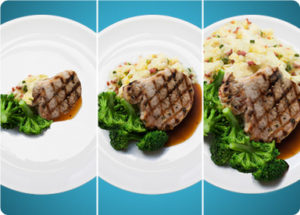It sounds so simple: Don’t eat or drink too much. But looks can be deceiving. It’s easy to eat or drink more than you planned to.
You can leave that mistake behind when you start to recognize a true serving size. Hint: It’s often smaller than you think it should be.
What Is a Serving Size?
Instead of trying to memorize lists of ounces, cups, and tablespoons, simply compare the serving sizes of foods to familiar things.
For example, a single serving of:
• Vegetables or fruit is about the size of your fist.
• Pasta is about the size of one scoop of ice cream.
• Meat, fish, or poultry is the size of a deck of cards or the size of your palm (minus the fingers).
• Snacks such as pretzels and chips is about the size of a cupped handful.
• Apple is the size of a baseball.
• Potato is the size of a computer mouse.
• Bagel is the size of a hockey puck.
• Pancake is the size of a CD.
• Steamed rice is the size of a cupcake wrapper.
• Cheese is the size of a pair of dice or the size of your whole thumb (from the tip to the base).
The best way to determine the amount of food in a serving is to look at the Nutrition Facts label and measure it.
*CGM-based treatment requires fingersticks for calibration, if patient is taking acetaminophen, or if symptoms/expectations do not match CGM readings, and if not performed, may result in hypoglycemia. Please see important risk and safety information.
 For example, fill a measuring cup with the proper-sized portion of vegetables, rice, etc. and then empty it onto a plate. That will help you learn what these serving sizes look like.
For example, fill a measuring cup with the proper-sized portion of vegetables, rice, etc. and then empty it onto a plate. That will help you learn what these serving sizes look like.
Watch the Portion Size
At home:
• Use smaller dishes at meals.
• Serve food in the right portion amounts, and don’t go back for seconds.
• Put away any leftovers in separate, portion-controlled amounts. Consider freezing the portions you likely won’t eat for a while.
• Never eat out of the bag or carton.
• Don’t keep platters of food on the table; you are more likely to “pick” at it or have a second serving without realizing it.
At restaurants:
• Ask for half or smaller portions.
• Eyeball your appropriate portion, set the rest aside, and ask for a doggie bag right away.
• If you have dessert, share.
At the supermarket:
• Beware of mini-sized snacks — small crackers, cookies, and pretzels. Most people end up eating more than they realize, and the calories add up.
• Choose foods packaged in individual serving sizes.
• If you like to eat ice cream out of the carton, pick up ice cream sandwiches or other individual-size servings.


Comments are closed